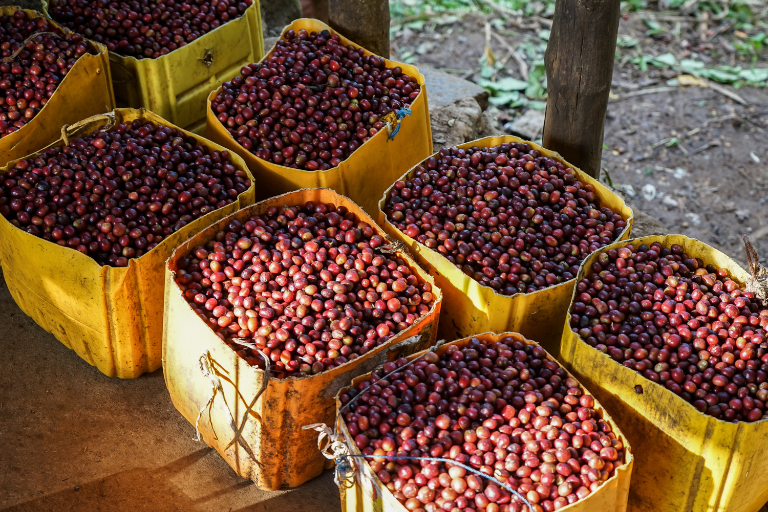COFFEE-PROCESSING METHODS: A FARMER’S PERSONAL TOUCH THAT TRANSFORMS THE COFFEE WE DRINK
By Tyler Workman

Take a few seconds and think through all the different fruits you consume. Now, carefully evaluate that list and name all the fruits where the seed—yes, just the seed—is the ONLY part you eat. I’m sure you can come up with a pretty long list of fruits where both flesh and seed are eaten, but are there any you can think of where you consume nothing but the seed?
Well, coffee is that fruit! This quick mental exercise is a fun segue into understanding this blog’s topic because of the emphasis on the coffee seed. By now, we have established that coffee is a fruit and that what we drink is the seed of that fruit after having gone through a roasting process (more about this in our previous blog, “Coffee Roasting: A Quick Overview of the Process and Fun Facts”). But did you know that there is a key step in the process that will directly impact the sweetness, acidity, body, and flavors of the coffee we drink? This step is known as a processing method, and it is the approach farmers choose to take that alters the course of the coffee seeds and ultimately determines the coffee’s fate: washed, honey, or natural (and yes, I will now explain what each of those are).

You may have thought that all coffee was processed the same, but that’s not the case. Historically, there have been three main processing methods in coffee—washed, honey, and natural—and they are going to be the focus of this blog. However, it is worth noting that there are new methods being developed as well; there are many experiments in variations and combinations of the main three as the world of coffee continues to evolve.
Choosing a processing method is no easy decision for a coffee farmer. It is a calculated and methodical choice with many factors that need to be considered, such as climate conditions, availability of natural resources, labor, time, scalability, and return on investment. This is why selecting a processing method is a very important decision that has direct implications for the profitability of the farmer’s coffee.
WASHED PROCESS
The objective of this method is to remove the coffee seeds from the cherry and wash them clean before they are dried.

The Process
This process involves two very important components. The first component is a machine called a depulper, and the depulper’s function is to separate the seeds from the cherries. Sometimes this is accomplished by a worker manually cranking a wheel, and sometimes it is done in a more automated way, with a motor. In both instances, the cherries enter the depulper, rotate through a drum where they are put under pressure that pulls the soft cherry flesh from the seeds, and exit the depulper with the cherry skins completely removed and the seeds ready for the next step. The second component is water—and lots of it. After separating the seeds from the cherries, the seeds must go through a thorough washing in order to remove a sticky layer around them (called mucilage). It often takes several rinses before the seeds are ready to be dried, so the amount of water used can be environmentally impactful.
The Result
The washed method is quicker to complete than the other methods and can be both efficient and easier to replicate for producers. This method has the shortest drying phase of all and is very common in most coffee-producing countries where water is a readily available resource. Washed coffees are typically described as having more distinct/identifiable tasting notes, with a lighter body and high brightness.
HONEY PROCESS
The objective of this method is to remove the coffee seeds from the cherry and dry them directly, without washing them.

The Process
This is an “in-between” method that also requires a depulper to remove the seeds from the coffee cherries. However, after the removal of the seeds, the producer does not wash the seeds but rather dries them with the mucilage still intact. There are three types of honey-process coffees that producers can achieve based on the amount of mucilage left on the seeds. These honey types are black, red, and white. You will notice the three colors in this picture: the darkest is the black honey coffee, the medium is the red honey coffee, and the light is the white honey coffee.
The Result
The honey method saves on water but takes longer to dry than the washed process. This is particularly important for producers because longer drying times means the coffee will use more resources before it can be sold. Honey coffees typically have more body and more sweetness than washed coffees and are also more complex.
NATURAL PROCESS
The objective of this method is to dry the entire coffee cherry as is before the seeds are separated through a milling process.

The Process
Also known as the dry process, the natural process is the “OG” of the processes, and it is the complete opposite of the washed method because the seeds will not be removed from the coffee cherries until the drying phase has been completed. After the cherries are picked, they go directly to the drying phase. Leaving the cherry skin on the seeds in this method helps enhance the sugar content of the coffee beans.
The Result
Because the entire cherry needs to be dried, the length of time it takes to dry is significantly longer than with washed coffees. Yes, there is a big advantage in not using water, but drying the entire cherry presents its own challenges. The coffee is more susceptible to mold and fungi, which creates a need for a careful drying process. Natural coffees are known to have more fruitiness and sugariness as well as a heavy body. They can also be described as winey, with fermented flavors.
The Takeaway
As consumers, we may think that coffee-processing methods are just an interesting fact to learn about, but it’s important to remember that for producers, choosing a method is a crucial decision that has many repercussions. What may seem like an easy choice on our end isn’t always that simple for farmers. They need to weigh the pros and cons of each method: the resources required, the drying times, and the profit they will receive for the final product (in general, the rarer the type of process, the more the coffee will sell for). Producers also have to determine what method complements their particular coffee the best, because every coffee is different and has unique characteristics to highlight—and these are often unlocked through the processing method. It takes a personal touch and knowing one’s coffee very well to select the best method for truly transforming the seeds into a masterpiece.


0 comments